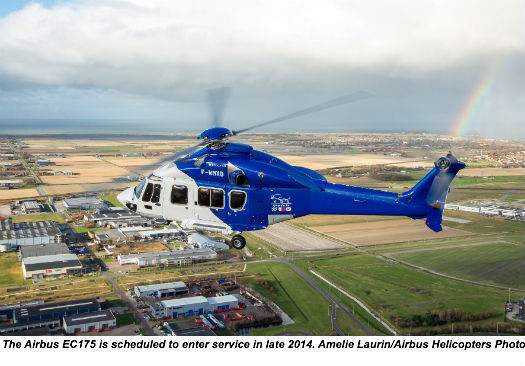
Launch customers Noordzee Helicopters Vlaanderen (NHV), UTair and Heli-Union are gearing up for the first deliveries and entry into service of the Airbus Helicopters EC175, which will take place in late 2014 following a series of recent demo tour stops around the North Sea, as well as in Asia and the United States.
After obtaining certification of the EC175 in January 2014, the manufacturer carried out steps to “optimize the aircraft in order to ensure a successful entry into service for the aircraft,” said Marc Allongue, head of the EC175 program. “The EC175 has flown a lot in different environments in order to gain experience.” He added that the recent demonstration tours sought to “improve the maturity” of the EC175, in addition to giving operators a first-hand look. And he said that the aircraft has been well-received — with operators impressed with the performance and efficiency of the type, along with the avionics system and machine interface.
“Since the beginning,” Allongue noted, “the EC175 has been developed with the customer in mind, and we’ve made several consultations with operators and the end-users all along the process.”
Among these was launch operator NHV. “Their input is important,” said Allongue. “Because they are offshore, they are aware much more than anybody else of the constraints of the operation.”
Allongue pointed to EC175 training as a recent achievement, with the first Level D full flight simulator (FFS) gaining certification from the European Aviation Safety Agency (EASA) in July. The simulator is based at the Helisim Training Academy next to the headquarters for Airbus Helicopters in Marignane, France.
Through mid-September, a total of nine pilots have gone through the training, according to Allongue, including instruction for operators using a fixed-base flight navigation procedures trainer (FNPT III) for oil-and-gas modules. In July, the first pilots from France’s Heli-Union became type-rated while the first technicians from Russia’s UTair became the first to receive maintenance training on an EC175 mock-up in Marignane.
Airbus Helicopters plans to expand the training network “all over the world, first in the U.S. starting in 2016, and then depending on operator locations, we’ll base additional full flight simulators in close proximity, possibly in Brazil for instance,” he said, adding that the company hasn’t decided yet on the location for the U.S. simulator. “Our intention is to duplicate what we have in Marignane location,” he continued. The maintenance network will continue to expand, and Airbus Helicopters plans to establish a dedicated 24-hour help desk and a mobile response team to provide technical support, maintenance, operations and logistical support.
There are currently 64 EC175s on order, mainly for oil and gas operators with less than 10 representing corporate/VIP operators, according to Allongue. The company’s stated intention when the variant was introduced in 2008 was to sell 800 to 1,000 EC175s over 20 years. That goal was recently codified as part of a framework agreement with Avicopter to create a 50-50 organization that will jointly produce the EC175 and its Chinese counterpart, the AC352. The partnership to produce 1,000 helicopters is valued at around €15 billion (U.S. $19.3 billion).
Airbus Helicopters has responsibility for certain parts of the helicopter, including the avionics, hydraulic system and main gearbox, while Avicopter is in charge of elements such as the structure and intermediate and tail gearboxes. Other than the EC175 featuring the Pratt & Whitney PT6-C67E engines and the AC352 receiving power from Turbomeca’s Ardiden 3 — and regional-specific mission systems — there are only a few differences between the European and Chinese versions of the EC175, Allongue explained, adding that both are “developed around a common standard vehicle.”
One of the key features — and one that led to a six-month delay in the EC175’s certification — is the third-generation Helionix avionics system. Allongue described it as “the main challenge we faced during the helicopter’s development.” Airbus Helicopters developed the proprietary system in an effort that proved to be “quite new” for the manufacturer. “This is a complex system in a complex environment, but in the end the product will be more reliable than ever at the entry into service,” he stated.
Production will start under a “progressive allotment” over the next two years, with around two helicopters per month. Airbus plans to increase that number to three EC175s per month starting in 2018. The first batch of helicopters will enter service with NHV, UTair and Heli-Union.









